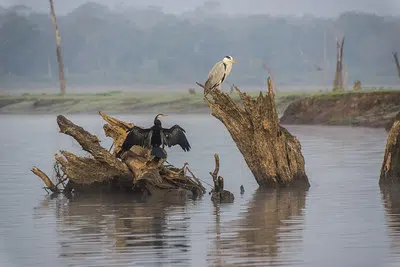Nagarhole National Park and Tiger Reserve – Rajiv Gandhi National Park
Overview
Nagarhole National Park is a national park situated in Mysore and Kodagu district of Karnataka, India. It is one of the most eminent tiger reserves and well-kept national park in India. It is a delightful destination for people who love Asiatic Elephants and Indian Tigers. The entire park is filled with captivating flora and fauna and has a broad range of wildlife living in it. You can also see a huge number and variety of birds and amphibians in it. Many rare mammals and birds can be spotted in the park, like, Nilgiri Wood Pigeon, Bengal Tiger, Chital, Blue Winged Parakeet, Indian Leopard, Sloth Bear, Striped Hyena, etc.
Information
It is also referred to as the Rajiv Gandhi National Park. The name of the park, Nagarhole is a combination of two Kannada words Naga, signifies snake, and Hole refers to streams, justifying its title as numerous streams meandering through the rich tropical forest of this national park. Initially, the park was an exclusive hunting reserve of the emperors of the Wodeyar Dynasty. It was set up as a Wildlife Sanctuary in 1955. In 1988, it was upgraded to National Park, and then in 1999, it was declared as a 37th Tiger Reserve of India. It is also put into consideration by UNESCO as a World Heritage site.
- Size – 642.39 km²
- Forest Type – North Western Ghats moist deciduous forests with prominence of teak and rosewood
Star Species
Nagarhole is surrounded by three parks Mudumalai, Wayanad Wildlife Sanctuary, and Bandipur. The River Kabini surrounds the park forming an aqueous border with the Bandipur National Park. This consolidated area of these two parks creates an astounding forest, making it a beautiful sight for tourists. The best way to witness this nature’s bounty, beautiful vegetation and the picturesque view is by staying in the resorts in Nagarhole National Park.
- Key Mammals – Indian Leopard, Bengal Tiger, Chital, Sloth Bear, Barking Deer, Dhole, Wild Boar, Four-Horned Antelope, Gaur, Indian Elephant
- Key Birds – Malabar Trogon, Malabar Grey Hornbill, Nilgiri Wood Pigeon, Blue Winged Parakeet, Oriental White Ibis, Darters, Greater Spotted Eagle.
How to reach
- By Train – The nearest railway station to Nagarhole National Park is situated in Mysore. Mysore railway station is just 80 Kms away from the Nagarhole. Mysore is connected to almost all the other major cities via rails. From the station, one can use any local transport or hire a cab to reach the park.
- By Air – The nearest international airport is Bangalore airport, situated 236 kms away from the park. Alternatively, Mysore airport is just 96 Kms from the park. Once you get down at the airport, there are a lot of regular transport services available, or you can hire a cab to reach Nagarhole National Park.
- By Road – There are many transportation services available to reach the park via road. The road connectivity is smooth and serves various public and private bus services to reach Nagarhole National Park.
Safari Zones
Karnataka Forest department conducts wildlife safari twice daily. The first slot is 6 am to 8 am and the second slot is 3 pm to 5 pm. Advance booking through a wildlife tour expert is recommended as the permit availability is limited. There are two zones for jeep safari in Nagarhole National Park:
- Nanchhi Gate, and
- Veeranahosalli Gate
Weather
| Month | Low Temp (°C) | High Temp (°C) |
| January | 16 | 30 |
| February | 17 | 32 |
| March | 19 | 33 |
| April | 20 | 34 |
| May | 20 | 32 |
| June | 20 | 27 |
| July | 19 | 25 |
| August | 19 | 24 |
| September | 19 | 26 |
| October | 19 | 27 |
| November | 18 | 28 |
| December | 17 | 28 |
Things to Carry
Clothing tips for the right safari experience:
- Clothes in the earthy colours to be worn which are greens, beige and grey. Black attracts mosquitoes and should be avoided. Shiny or bright colours are a big no.
- Clothes as per expected weather are very important:
- Summer clothes to be carried should be preferably cotton or cotton blend that is comfortable, breathable.
- Winter clothes to be packed should be planned for layering over each other when worn. Advisably 4-5 woollen clothes than one heavy item.
- A raincoat or a windcheater is also recommended.
- A hat or a cap as per the weather or season is also prescribed.
- Avoid wearing strong fragrances on the safari.
Gallery





